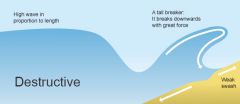![]()
![]()
![]()
Use LEFT and RIGHT arrow keys to navigate between flashcards;
Use UP and DOWN arrow keys to flip the card;
H to show hint;
A reads text to speech;
45 Cards in this Set
- Front
- Back
|
What is the definition of a coast? |
A narrow strip of land between the land and the sea |
|
|
What are the four processes of coastal erosion? |
Hydraulic action, corrasion (abrasion), corrosion and attrition |
|
|
What is hydraulic action? |
The pressure and weight of the water thrown against the cliffs, eroding them. It also compresses the air in cracks in rocks, breaking them apart, known as hydraulic pressure. |
|
|
What is Corrasion (or abrasion)? |
The act of rock in the sea being thrown against the cliffs, eroding them away. Similar to sand-blasting |
|
|
What is corrosion? |
The acid in the sea water 'eating away' at the cliffs |
|
|
What is attrition? |
The act of rocks bumping into each other in the sea, wearing them down. |
|
|
What does 'fetch' mean? |
The maximum distance wind can travel over air to make waves, the greater the fetch, the larger the waves. |
|
|
What is the difference between a constructive and a destructive wave? |
Constructive: Strong swash, weak backwash, low energy, low wave height, long wave length, break less frequently. MAKE beaches Destructive: Weak swash, strong backwash, high energy, high wave height, break frequently, short wave length. DESTROY beaches |
|

What type of wave is this? |

|
|

What type of wave is this? |

|
|
|
When and How are headlands and bays formed? |
They are formed when there are bands of hard and soft rock at 90 degrees to the coastline. 1) Waves erode the less resistant soft rock through hydraulic action and abrasion. 2) This forms bays in the softer rock which has retreated faster (often with beach), and with headlands that stick out into the sea, sheltering the bays. 3) The headlands are now most vunerable to erosion, and the whole thing retreats |
|
|
What are headlands? |
Areas of hard resistant rock jutting out into the sea |
|
|
What are bays? |
Area of a coastline which have been eroded in because of their soft rock, protected by headlands on either side |
|
|
How is a wave cut notch formed? |
A weakness at the bottom of a cliff is slowly eroded using hydraulic action and abrasion and made larger into a notch. |
|
|
How is a wave cut platform formed? |
1) When a wave cut notch becomes enlarged, the cliff above is unsupported and collapses into the sea. 2) Over time, the cliff retreats and gets higher. 3) The expanse of cliff left behind on the foreshore is called a wave cut platform and is exposed at high tide |
|
|
How are caves, arches, stacks and stumps formed? |
1) Erosion by waves causes small weaknesses in the cliff base to widen and form a cave. 2) Continual erosion at this cave can cause it to break through the headland, forming arches 3) The waves continue to erode the base of the arch until it becomes too heavy and collapses, forming a stack 4) The bottom of the stack is eroded and it will eventually collapse, forming a stump |
|
|
What (with detail) are the 4 ways the sea transports materials? |
1) Traction - Heavy objects are dragged along the floor of the sea bed 2) Saltation - Sand sized particles are bounced along the sea bed 3) Suspension - Clay sized particles are floated along in the sea water 4) Solution - Some minerals are dissolved in the sea water |
|
|
What is a spit? |
A long narrow accumulation of sand and shingle, attached to the land at one end and the other sticking out to sea |
|
|
What is LSD and what does it do? |
Long Shore Drift - Swash move materials up the beach in the same direction as the wind, before they are dragged vertically back to sea. This zig-zag repeats, moving the sand along the beach. |
|
|
How are spits formed? (+ Salt marshes) |
1) LSD move materials down a coastline 2) The coastline changes direction and the LSD deposits it's materials. Depositing the heavy material first 3) The LSD continues to move in a straight line, building up in that direction. 4) A wind change can cause the end of the spit to become hooked or recurved. 5) Salt marshes form behind the spit because the wave action is reduced and deposition occurs there. 6) If a river estuary occurs, the flow of water will stop the spit from continuing across the mouth of the river |
|
|
What is a bar and how is it formed? |
A bar is a strip of sand stretching across a bay. It is formed when either a spit grows across a bay or an offshore sand bank migrates inland. Behind the bar, a lagoon is formed. |
|
|
What is weathering, and what are three main types? |
The Physical breakdown or rocks by the weather Physical, Chemical and Biological. |
|
|
What is/are the example/s of physical weathering? |
Freeze-thaw - When water entres the cracks in rocks and freezes, it expands, cracking the rocks, and then when it melts, it moves further down the crack and the process is repeated Exfoliation - At hot times, the rocks heat up and expand, then cool at night, causing layers of rock to break off - Also called onion skin weathering |
|
|
What is/are the example/s of chemical weathering? |
Solution weathering - Rain water can contain weak acid which reacts with rocks like limestone, dissolving the rocks away - happens to church gravestones` |
|
|
What is/are the example/s of biological weathering? |
Burrowing rabbits can burrow in rocks, weakening them Plant seeds can fall into rocks, and their roots will grow, breaking apart rocks. |
|
|
What are the three types of mass movement? |
Land slumping, Soil creep and rockfalls. |
|
|
Describe Land Slumping. |
After long periods of dry weather, weak rocks, such as clay, will form cracks which water can fall in. This then saturates the rock, making it heavier and due to gravity it slips down slope. MEDIUM PACED MOVEMENT |
|
|
Describe Soil Creep. |
Gravity slowly pulls the water in soil downhill, moving the soil with it. When it rains the soil expands at 90° to the slope, and then it is pulled by gravity downhill again. SLOW PACED MOVEMENT |
|
|
Describe Rockfalls. |
Freeze-thaw and exfoliation provide lines of weakness in a cliff face, loosening rocks, and then gravity pulls these down fast, as a rockfall. The debris at the base is called SCREE. |
|
|
What is the definition of a beach? |
An area of land between low tide and storm tide marks, made of sand, shingle, mud and silt. |
|
|
Where and why do beaches form? |
They form because of constructive waves depositing material along the coastline. They often occur in bays, because there is less energy for waves there, so deposition is more likely. It also occurs on straight stretches of coast where LSD operates. |
|
|
What are the two main types of beach and why do they form? |
Sandy beaches - Backwash tends to carry the finer material down the beach Shingle beaches - heavier material is carried up the beach as the swash is greater than the backwash |
|
|
What are the main factors that affect how much nature affects a coastline? |
1) Power of the wave - Determined by the fetch 2) Beach gradient - Gentle beaches cause more friction, so waves lose energy quickly 3) Type of rocks - More resistant rocks erode slower 4) Rock structure - Better jointed rocks erode much faster because the waves exploit the areas of weakness 5) Cliff gradient - Gentler cliffs are more resistant to erosion than bare rock cliffs |
|
|
What are the two methods of protecting a coastline? |
Hard engineering - involves large construction works. e.g. building a seawall Soft engineering - Works that work with nature trying to not be visually obtrusive. e.g. beach replenishment |
|
|
What is rip rap, what type of engineering is it and what are some of the pros/cons? |
Large rocks placed in front of cliffs - HARD Pros - Disapates wave energy - Effective for years - Cheap Cons - Ugly - Useless in storms - Can make beach unaccsessable |
|
|
What is a recurved seawall, what type of engineering is it and what are some of the pros/cons? |
Concrete walls with a recurved face - HARD Pros - VERY effective - Visible (feel safe) Cons - Ugly - Very expensive |
|
|
What are groynes, what type of engineering is it and what are some of the pros/cons? |
Wood barriers stretching into sea - HARD Pros - Prevents LSD - builds a beach - Effective for years Cons - Unattractive (hard to walk around) - Disrupt natural processes, LSD |
|
|
What are gabions, what type of engineering is it and what are some of the pros/cons? |
Wire cages filled with stones - HARD Pros - Very Cheap - Absorb wave energy Cons - Cages can break - Not as efficient |
|
|
What is an offshore reef, what type of engineering is it and what are some of the pros/cons? |
Large concrete blocks sunk offshore to disrupt wave energy - HARD Pros - Reduces wave power - Allows build up of a beach Cons - Phenomonally expensive - Difficult to install |
|
|
What are revetments, what type of engineering is it and what are some of the pros/cons? |
Wooden barriers on the beach to break waves - HARD Pros - Protect beach - VERY effective Cons - Relatively expensive - Short life
|
|
|
What is beach replenishment, what type of engineering is it and what are some of the pros/cons? |
The placing of sand and pebbles onto a beach - SOFT Pros - Best form of natural defensive -Cheap Cons - May affect plants - Annual replenishment needed |
|
|
What is cliff regrading, what type of engineering is it and what are some of the pros/cons? |
The cutting of a coast to a lesser angle to stop slumping and erosion - SOFT Pros - Very natural - Can be covered with eco-matting Cons - Land may be lost - Not effective alone |
|
|
What is managed retreat, what type of engineering is it and what are some of the pros/cons? |
Allowing the sea to flood and erode areas - SOFT Pros - Can be very cheap/free - Creates new habitats Cons - Landowners lose out - Difficult to estimate sea movement |
|
|
What are the main groups and what do they do to help predict coastal flooding? |
Met Office - Weather warnings, Weather forecast, advises people to be proactive Environment agency - System of warning codes, tell people what to expect and how to react, monitors sea conditions The Government - Advise on how to act in a flood DEFRA - Provides money to protect areas LOCAL COUNCILS - Will not grant planning permission to houses that are not flood proof in flood areas |
|
|
What are the three flood warning codes and what do they mean? |
FLOOD ALERT - Flooding is possible, be prepared FLOOD WARNING - Flooding is expected, immediate action needed SEVERE FLOOD WARNING - Severe flooding and risk to life and property ALL CLEAR - no more risk of flooding expected |

